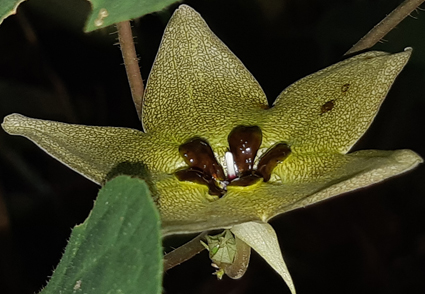Abstract
Dictyanthus includes 17 climbing species distributed from northern Mexico to Nicaragua. Mexico is its main center of diversification with 15 endemic species. The genus is known for its conspicuous flowers with high ornamental potential. Dictyanthus species are distinguished by the shape of their corolla (campanulate or rotated), their pattern of color lines or reticulations on the corolla lobes, the size and shape of their corona, and the shape of the stylar head. The present work formally names as a new species, and describes and illustrates the plants with a long and conspicuous stylar head, distinguishing it from the rest of its relatives. The study consisted of field work for two years, as well as a review of herbarium material and literature. The description of the organism was based on in situ morphology, herbarium material and specimens preserved in ethanol. The conservation assessment was based on IUCN criteria. We follow the cohesive species concept as an explanatory hypothesis for the taxa. A dichotomous key and comparative plates are presented for species with stylar head projection. Dictyanthus unicornus differs from other species in the genus by its conspicuously elongated stylar head and the combination of patent corolla lobes and fleshy, spatulate crown lobes protruding from the corolla throat. According to IUCN criteria, this species is considered Endangered. With the present discovery, the genus Dictyanthus reaches 18 described species of which 16 endemic to Mexico.
References
- Alvarado-Cárdenas, L.O., Lozada-Pérez, L., Islas-Hernández, C.S., Cortez, E.B., Maya-Mandujano, K.G. & Chávez-Hernández, M.G. (2020) Apocináceas de ayer y hoy. Conocimiento histórico y reevaluación de la diversidad y distribución de Apocynaceae en México. Botanical Sciences 98 (2): 393–416. https://doi.org/10.17129/botsci.2525
- Alvarado-Cárdenas, L.O., López Hernández, A. & Sánchez, R. (2022) A remarkable new species of Dictyanthus (Apocynaceae, Asclepiadoideae, Asclepiadeae, Gonolobinae) restricted to Jalisco, México. Phytotaxa 558: 178–184. https://doi.org/10.11646/phytotaxa.558.2.2
- Aublet, J.B.C.F. (1775) Histoire des Plantes de la Guiane Françoise Tome I. Pierre-François Didot, London, 621 pp.
- Bachman, S., Moat, J., Hill, A., de la Torre, J. & Scott, B. (2011) Supporting Red List threat assessments with GeoCAT: Geospatial Conservation Assessment Tool. ZooKeys 150: 117‒126. https://doi.org/10.3897/zookeys.150.2109
- Decaisne, J. (1844) Asclepiadaceae. In: de Candolle, A.P. (Ed.) Prodromus Systematis Naturalis Regni Vegetabilis 8. Paris, France, pp.490–665.
- Demarco, D. (2017) Floral glands in asclepiads: structure, diversity and evolution. Acta Botanica Brasilica 31: 477–502. https://doi.org/10.1590/0102-33062016abb0432
- Endress, M.E., Meve, U., Middleton, D.J. & Liede-Schumann, S. (2018) Apocynaceae. In: Kadereit, J.W. & Bittrich, V. (Eds.) Flowering Plants. Eudicots, The Families and Genera of Vascular Plants 15. Springer International Publishing AG, pp. 207–411. https://doi.org/10.1007/978-3-319-93605-5_3
- González-Martínez, C.A., Lozada-Pérez, L. & Alvarado-Cardenas, L.O. (2019) Dictyanthus stevensii (Apocynaceae; Asclepiadoideae; Gonolobinae), a new species from Chimalapas region, Oaxaca, Mexico. Phytotaxa 394: 79–88. https://doi.org/10.11646/phytotaxa.394.1.5
- IUCN Standards and Petitions Subcommittee (2019) Guidelines for using the IUCN red list categories and criteria. Version March 13.
- McDonnell, A., Parks, M. & Fishbein, M. (2018) Multilocus Phylogenetics of New World Milkweed Vines (Apocynaceae, Asclepiadoideae, Gonolobinae). Systematic Botany 43: 77–96. https://doi.org/10.1600/036364418X697021
- Naturalista (2023) Naturalista. CONABIO, México. Available from: https://www.naturalista.mx/ (accessed: June 2023)
- Pío-León, J.F., Delgado-Vargas, F., León-de la Luz, J.L. & Ortega-Rubio, A. (2017) Prioritizing wild edible plants for potential new crops based on deciduous forest traditional knowledge by a rancher community. Botanical Sciences 95: 47–59. https://doi.org/10.17129/botsci.772
- Smith, J.D. (1893) Undescribed plants from Guatemala. XI. Botanical Gazette 18 (6): 197–211. https://doi.org/10.1086/326937
- Standley, P.C. (1924) Trees and Shrubs of Mexico. Asclepiadaceae. Contributions from the United States National Herbarium 23: 1183–1184. [US Government Printing Office]
- Stevens, W.D. (1975) Notes on the genus Matelea (Apocynaceae s. l.). Phytologia 32: 387–406.
- Stevens, W.D. (1988) A synopsis of Matelea subg. Dictyanthus (Apocynaceae: Asclepiadoideae). Annals of the Missouri Botanical Garden 75: 1533–1564. https://doi.org/10.2307/2399300
- Stevens, W.D. (2000) New and interesting milkweeds (Apocynaceae, Asclepiadoideae). Novon 10: 242–256. https://doi.org/10.2307/3393108
- Stevens, W.D. (2005) Fourteen new species of Gonolobus (Apocynaceae, Asclepiadoideae) from Mexico and Central America. Novon 15 (1): 222–244. Available from: https://www.jstor.org/stable/3393422 (accessed: 27 December 2023).
- Stevens, W.D. (2009) Dictyanthus. In: Davidse, G., Sousa, S., Knapp, M. & Chiang, F. (Eds.) Flora Mesoamericana volumen 4, parte 1 Cucurbitaceae a Polemoniaceae. Universidad Nacional Autónoma de México, Instituto de Biología; Missouri Botanical Garden; The Natural History Museum, London, pp. 711–713.
- Templeton, A.R. (1989) The meaning of species and speciation: a genetic perspective. The units of evolution: Essays on the nature of species 1992: 159–183.
- Thiers, B. (2021) [continuously updated] Index Herbariorum: A global directory of public herbaria and associated staff. New York Botanical. Available from: http://sweetgum.nybg.org/ih (accessed: 1 September 2021).
- Yetman, D. & Van Devender, T.R. (2002) Mayo ethnobotany: land, history, and traditional knowledge in northwest Mexico. University of California Press, Los Angeles, 359 pp. https://doi.org/10.1525/california/9780520227217.001.0001
- Woodson, E.R.Jr. (1941) North American Asclepiadaceae. I. Perspective of the genera. Annals of the Missouri Botanical Garden 28: 193–244. https://doi.org/10.2307/2394270


